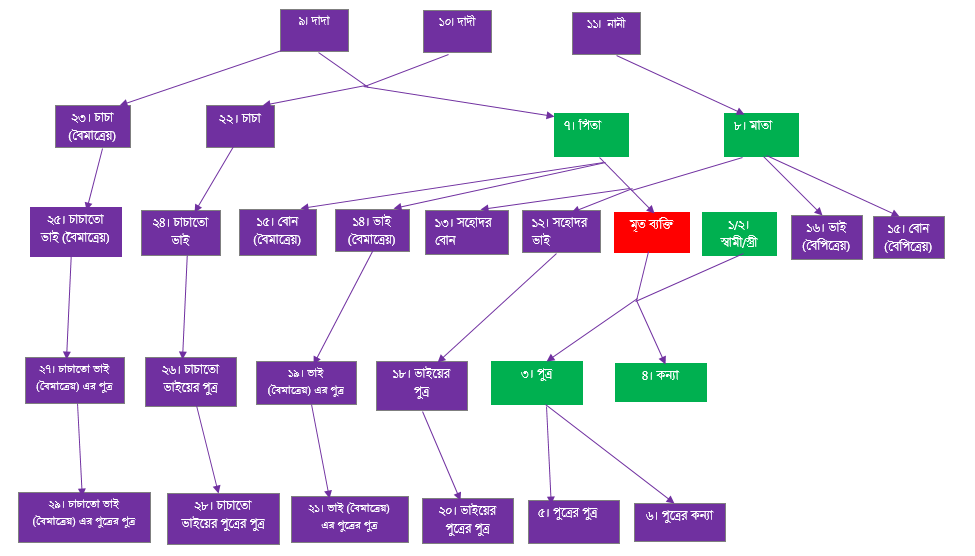Quranic Heir:
The Holy Quran has been set the parts. 12 pepoles are Quranic Heir. Among them, 8 men and 4 women. 4 men are - (1) Husband, (2) Father, (3) Grand Father, (4) Uterine Brother। The amount determined as follows: - (1) Wife, (2) Daughter, (3) Son`s Daughter, (4) Mother, (5) Paternal Grandmother and Maternal Grandmother , (6) Full Sister, (7) Consanguine Sister, (8) Uterine Sister। The amount determined as follows:
(1) Husband gets 1/4 when there is a child or son's child(h.l.s).
(2) Husband gets 1/2 when there is no child or no son's child(h.l.s).
(3) Wife gets 1/8 when there is a child or son's child(h.l.s).
(4) Wife gets 1/4 when there is no child or no son's child.
(5) Daughter gets 1/2 when there is only one daughter and there is no son.
(6) Daughter gets 2/3 when there is two or more daughters and there is no son.
(7) Daughter converted into a residuary if there is a son or 1 or more sons.
(8) Son's daughter gets 1/2 when there is only one and there is no son,or son's son or one or more daughters or higher son's daughter.
(9) Son's daughter gets 2/3 when there is two or more and there is no son,or son's son or one or more daughters or higher son's daughter.
(10) Son's daughter converted into a residuary by son's son equal or even low grade.
(11) Father gets 1/6 when there is a son or son's son(h.l.s).
(12) Father gets 1/6 and residuary when there are one or more daughters, son's daughters and there is no son or son's son.
(13) Father converted into a residuary when there is no child or no son's child.
(14) Mother gets 1/6 when there is a child or son's child(h.l.s) or two or more brothers or sisters whether full blood or half and whether they inherit or are excluded or there is a brother and sister and the father.
(15) Mother gets 1/3 when there is no child nor son's child and not more than one brother and sister.
(16) Mother gets 1/3 of residuary when there is a wife or husband and the father.
(17) True grand-father gets 1/6 when there is a child or son's child(h.l.s) and no father or no nearer true grandfather.
(18) True grand-father gets 1/6 and residuary when with daughters or only son's daughters.
(19) True grand-father converted into a residuary if there is no descendant sharer or residuary.
(20) True grand-mother gets 1/6 whern there is no mother and no nearer true grandmother.
(21) Full sister gets 1/2 when there is only one and when there is no child or son's child(h.l.s) or father or brother.
(22) Full sister gets 2/3 when there is two or more and when there is no child or son's child(h.l.s) or father or brother.
(23) Full sister converted into a residuary by full brother, that is when with one or more full brothers subject to not being excluded or when with one or more daughters or son's daughters and no excluder the full sisters one or more become residuary with daughters. They take care the residuary after deducting the shares of daughters.
(24) Consanguine sister gets 1/2 when there is only one and there is no child or no son's child(h.l.s.) or father or brother or full sister.
(25) Consanguine sister gets 2/3 when there is two or more and there is no child or no son's child(h.l.s.) or father or brother or full sister.
(26) Consanguine sister gets 1/6 when there is one full sister only.(the sister takes 1/2 and Consanguine sister takes (2/3-1/2=1/6).
(27) Consanguine sister converted into a residuary by a Consanguine brother.When there are one or more daughters, or son's daughters and no excluder.
(28) Uterine brother gets 1/6 when there is only one uterine brother and there is no child or no son's child(h.l.s.) or father,(h.h.a.).
(29) Uterine brother gets 1/3 when there is two or more uterine brothers and there is no child or no son's child(h.l.s.) or father,(h.h.a.).
(30) Uterine sister gets 1/6 when there is only one uterine sister and there is no child or no son's child(h.l.s.) or father,(h.h.a.).
(31) Uterine sister gets 1/3 when there is two or more uterine sisters and there is no child or no son's child(h.l.s.) or father,(h.h.a.).
Assaba or Residuary
(1)। Assaba has four Classes:
Class (1): (1)) Son, (2))Daughter, (3))Son`s Son, (4)) Son`s Daughter
Class (2): (1))Father, (2))Grand Father
Class (3): (1))Full Brother, (2)) Full Sister, (3))Consanguine Brother, (4))Consanguine Sister, (5))Full Nephew, (6))Paternal Nephew, (7))Full Nephews Son, (8)) Paternal Nephew`s Son।
Class (4): (1))Full Uncle, (2))Paternal Uncle, (3))Full Paternal Uncle’s Son, (4))Paternal Uncle’s Son, (5))Full Cousin`s Son, (6))Paternal Cousin`s Son, (7))Full Cousin`s Grandson, (8))Paternal Cousin`s Grandson
(2)। If only men or women of Asaba, the remaining portion will be given to men or women. If men or female fall under asaba category, men and women 2:1 will be residuary.
Property Distribution Process:
Step:(1) - First, the property must be divided among those jabiula phuruja.
Step:(2) - If Jabiula Phuruja portion merges togther and is greater than 1, all share will be reduced proportionally so that entire share is 1.
Step: (3) - IF you’re not an Asaba and the share of husband and wife which is less than 1, will be merged together with jabiula phurja to increase up to total of 1. The share of husband and wife is strictly specified.
Step: (4) - If conditions fall under Asaba, the remaning share will be distributed to the people of asaba by the following:-
Step: (1) >Step: (2)>Step: (3)>Step: (4)
(If class 1, then the next class of people from Asaba will be deprived from the property, If class 2, then the next class of people from Asaba will be deprived from the property, This will comtinue)
উত্তরাধিকার মোবাইল অ্যাপটি ডাউনলোড করতে ক্লিক করুনঃ ডাউনলোড
 =
=
(1) As heirs of a person's brother, sister and daughter left behind. What is the form of distribution of property among the heirs of the person?
Answers: Heirs = Brother + Sister + Daughter = 1/3 + 1/6 + 1/2
(2) As heirs of a person’s son, daughter and sister left behind. What is the form of distribution of property among the heirs of the person?
Answers: Heirs = Son + Daughter + Sister = 2/3 + 1/3 + 0
(3) As heirs of a person’s father, paternal grandfather, mother, paternal grandmother, daughter, and son left behind. What is the form of distribution of property among the heirs of the person?
Answers: Heirs = Father + mother + paternal grandfather + paternal grandmother + daughter + son’s daughter= 1/3+0+1/6 + 0+ 1/2 + 1/6
(4) As heirs of a person's mother, brother, sister, and daughter left behind. What is the form of distribution of property among the heirs of the person?
Answers: Heirs = Mother + Brother + Sister + Daughter = 1/6+ 2/9 + 1/9+1/2
(5) As heirs of a person's mother, paternal grandmother, maternal grandmother and uncle had left behind. What is the form of distribution of property among the heirs of the person?
Answers: Heirs = Mother + paternal grandmother + maternal grandmother + Paternal uncle = 1/3+ 0+0+2/3
(6) As heirs of a person's daughter, mother and sister left behind. What is the form of distribution of property among the heirs of the person?
Answers: Heirs = Daughter + Mother + Sister = 1/2+ 1/6+1/3
(7) As heirs of a person's mother, father and wife left behind. What is the form of distribution of property among the heirs of the person?
Answers: Heirs = Mother + Father + Wife = 1/4+ 1/2+1/4
((8) As heirs of a man's wife, son and daughter left behind. What is the form of distribution of property among the heirs of the person?
Answers: Heirs = Wife + Son + Daughter = 1/8+ 7/12+7/24
(9) As heirs of a man's wife, brother and sister survived. What is the form of distribution of property among the heirs of the person?
Answers: Heirs = Wife + Brother + Sister = 1/4+ 1/2+1/4
(10) As heir of a person’s Mother and Son left behind. What is the form of distribution of property among the heirs of the person?
Answers: Heirs = Mother + Son = 1/6+ 5/6
(11) As heir of a person’s Mother and Daughter left behind. What is the form of distribution of property among the heirs of the person?
Answers: Heirs = Mother + Daughter = 1/4+ ¾
(12) As heirs of a person's mother, daughter and sister survived. What is the form of distribution of property among the heirs of the person?
Answers: Heirs = Mother + Daughter + Sister = 1/6+ 1/2+1/3
(13) As heirs of a man's wife, 1 sister, half-sister (Father Side) and 2 half-sister (Mother Side) left behind. What is the form of distribution of property among the heirs of the person?
Answers: Heirs = Wife + 1 Sister + half-Sister (Father Side) + 2 half-Sister (Mother Side) = 1/4+ 1/2+1/6 + 1/3 (Primarily) = 3/15+ 6/15+2/15 + 4/15 (Distributed property, so the property would be reduced proportionately) (Awal Rule)
(14) As heirs of a person’s father, mother, husband, 2 sister and son’s daughter left behind. What is the form of distribution of property among the heirs of the person?
Answers: Heirs = Father + Mother + Husband + 2 Sisters + Son’s daughter = 1/6+ 1/6+1/4 + 2/3+0 (Primarily) = 2/15+ 2/15+3/15 + 8/15+0 (Awal Rule)
(15) As heirs of a person’s father's father, father, husband, 2 daughters, son’s daughter, full Sister left behind. What is the form of distribution of property among the heirs of the person?
Answers: Heirs = Father’s Father + Father + Husband + 2 Daughters + Son’s Daughter + Full sister = 0+ 1/6+ 1/4+ 2/3+0+0 = 0+ 2/13+ 3/13+ 8/13+0+0 (Awal Rule)
(16) As heirs of a person’s daughter, brother, mother and sister left behind. What is the form of distribution of property among the heirs of the person?
Answers: Heirs = Daughter + Brother + Mother + Sister = 1/2+ 2/9+ 1/6+1/9
(17) As heirs of a person daughter, wife, brothers and sisters left behind. What is the form of distribution of property among the heirs of the person?
Answers: Heirs = Daughter + Wife + Brother + Sister = 1/2+ 1/8+ 1/4+1/8
(18) As heirs of a man the father, mother, wife and brother left behind. What is the form of distribution of property among the heirs of the person?
Answers: Heirs = Father +Mother + Wife + Brother = 1/2+ 1/4+ 1/4+0
(19) 19. As heirs of a person's husband, daughter, father and mother left behind. What is the form of distribution of property among the heirs of the person?
Answers: Heirs = Husband + daughter + Father + Mother = 1/4+ 1/2+ 1/6+1/6 (Primarily) = 1/13+ 6/13+2/13 + 2/13 (According to awal Rule)
(20) As heirs of a person's wife, 2 daughters, father and mother left behind. What is the form of distribution of property among the heirs of the person?
Answers: Heirs = Wife + 2 Daughter + Father + Mother = 1/8+ 2/3+ 1/6+1/6(Primarily) = 3/27+ 16/27+4/27 + 4/27(According to awal Rule)
(21) As heir of a person’s husband, mother, 2 full sisters and 2 half-sisters (Father Side) left behind. What is the form of distribution of property among the heirs of the person?
Answers: Heirs = Husband + Mother + 2 Full sisters + 2 half-sisters = 1/2+ 1/6+ 2/3+1/3 (Primarily) = 3/10+ 1/10+4/10 + 2/10 (According to Awal Rule)
(22) As heirs of a person's mother, daughter and wife left behind. What is the form of distribution of property among the heirs of the person?
Answers: Heirs = Mother + Daughter + Wife = 1/6+ 1/2+ 1/8 (Primarily) = 7/32+ 21/32+1/8 (according to Radd Rules)
(23) As heirs of a person’s husband and 3 daughters left behind. What is the form of distribution of property among the heirs of the person?
Answers: Heirs = Husband + 3 Daughters = 1/4+ 2/3 (Primarily) = 1/4+ ¾ (According to Radd Rules)


